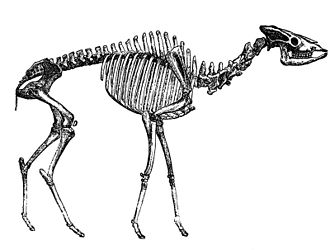Giraffidae
This article needs additional citations for verification. (February 2009) |
| Giraffidae Temporal range: Early Miocene - Recent
| |
|---|---|

| |
| An Okapi in Bristol Zoo, England. | |
| Scientific classification | |
| Kingdom: | |
| Phylum: | |
| Class: | |
| Order: | |
| Suborder: | |
| Infraorder: | |
| Superfamily: | |
| Family: | Giraffidae Gray, 1821
|
| Genera | |
| |
The giraffids are ruminant artiodactyl mammals that share a common ancestor with deer and bovids. The biological family Giraffidae, once a diverse group spread throughout Eurasia and Africa, contains only two living members, the giraffe and the okapi. Both are confined to sub-saharan Africa: the giraffe to the open savannas, and the okapi to the dense rainforest of the Congo. The two species look very different on first sight, but share a number of common features, including a long, dark-coloured tongue, lobed canine teeth, and horns covered in skin, called "ossicones".
Features
Giraffids share many common features with other ruminants. They have cloven hooves and cannon bones, much like bovids, and a complex, four-chambered stomach. They have no upper incisors or canines, replacing them with a tough, horny pad. There is an especially long diastema between the front and cheek teeth. The latter are selenodont, adapted for grinding up tough plant matter. [1] Like most other ruminants, the dental formula for giraffids is:
| Dentition |
|---|
| 0.0.3.3 |
| 3.1.3.3 |
The behavior of the two living species shows little commonality, probably because of their different habitats and ecology.

Their closest fossil relatives include the deer-like palaeomerycids and the climacocerids, many genera of the latter having once been identified as giraffes themselves.
Fossil records indicate that many other giraffids thrived between the Miocene era (around 20 million years ago) and the recent past. One major group of extinct giraffids, the sivatheres, had enormous branching ossicones, and would have looked more like massive deer than giraffes.
Classification

- ORDER ARTIODACTYLA
- Suborder Ruminantia
- Infraorder Pecora
- Superfamily Giraffoidea
- Family Climacoceratidae
- Family Giraffidae
- †Birgerbohlinia
- †Bohlinia
- †Bramatherium
- †Decennatherium
- Giraffa including the Giraffe, Giraffa camelopardalis
- †Giraffokeryx
- †Helladotherium
- †Honanotherium
- †Macedonitherium
- †Mitilanotherium
- Okapia including the Okapi, Okapia johnstoni
- †Palaeogiraffa
- †Paleotragus
- †Progiraffa
- †Propalaeomeryx
- †Samotherium
- †Shansitherium
- †Sivatherium
- Superfamily Giraffoidea
- Infraorder Pecora
- Suborder Ruminantia
References
- ^ Pellew, Robin (1984). Macdonald, D. (ed.). The Encyclopedia of Mammals. New York: Facts on File. pp. 534–541. ISBN 0-87196-871-1.